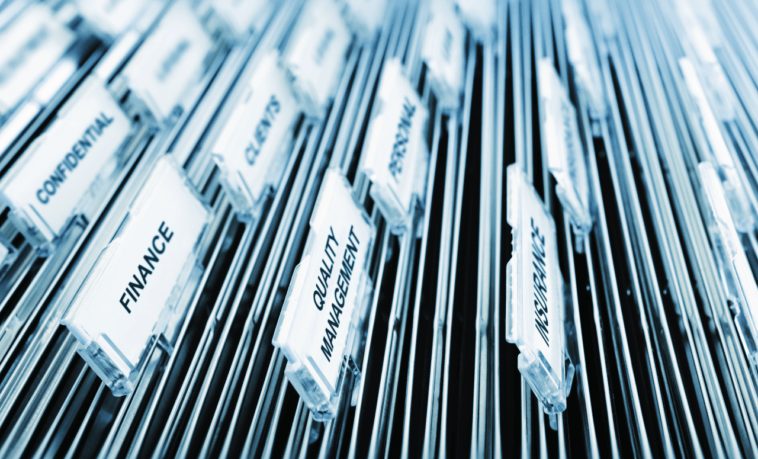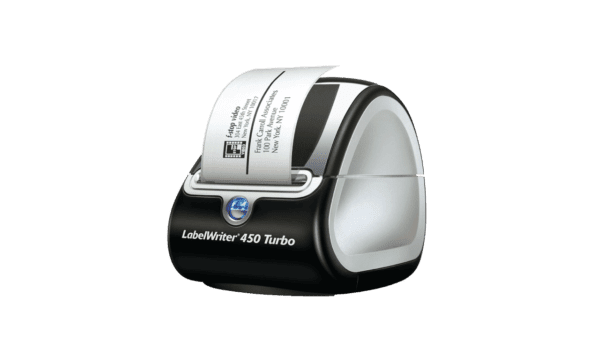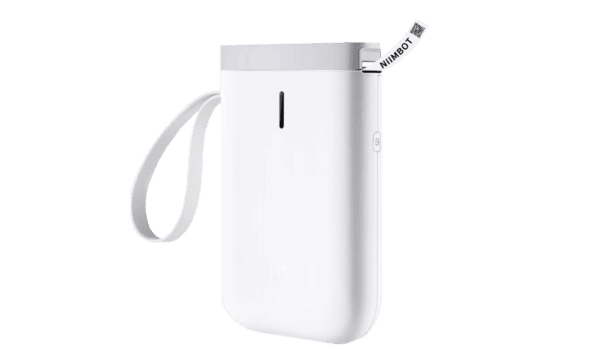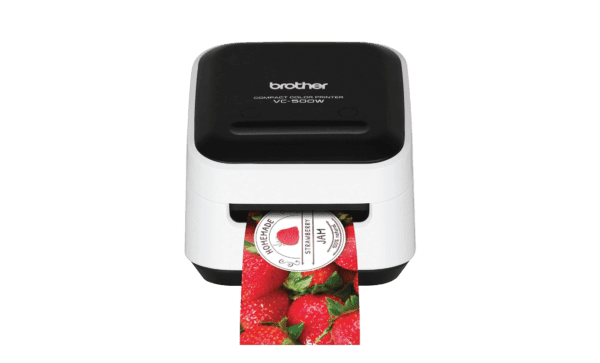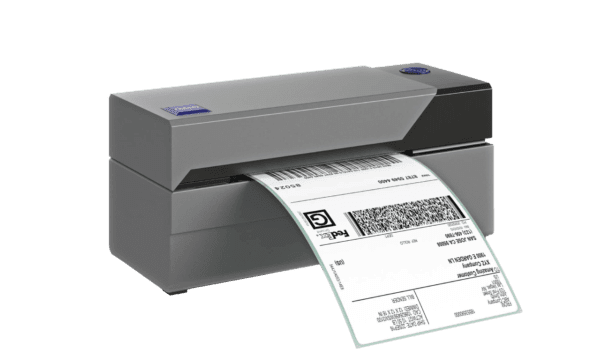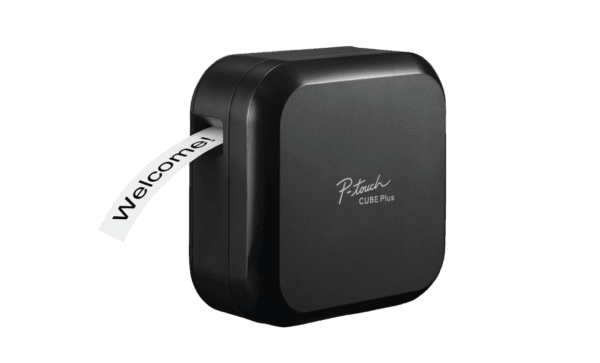Who doesn’t love a label printer? There’s nothing like looking around your workspace and seeing it organized just the way you like it, with everything clearly labeled. Or perhaps instead you do a lot of shipping and you’re tired of constantly running to the local UPS store. Bring that operation in-house with the best label printer. Besides printing labels, though, what else do you need to look for in a label printer for a small business?
BP’s Picks for Best Label Printer for Small Business
- Best Overall: The LabelWriter 450 Turbo
- Best Low-Volume: NiiMbot D11
- Most Versatile: Brother VC-500W
- Best High-Speed: Rollo Label Printer
- Best Mobile Integration: Brother P-Touch Cube Plus
Turns out, there’s a lot to know about label printers, and choosing the one that’s right for you and your business is more difficult than it might seem at first. Do you need color labels, or just black and white? What size labels will you need? What other label printer functions are you not considering? In this ranking, we answer these questions and a whole lot more.
What’s certain is that with a relatively small up-front investment, a new label printer for your small business will pay dividends in the long run. Just don’t get overzealous and label your stapler and coffee mug.
Is a Label Printer Worth It?
As home-based businesses through sites like Etsy have become increasingly common, so has the need for label printing, as orders are prepared and shipped straight from the home office. If you have a reasonably small number of orders, you can of course buy your own self-adhesive half sheets (we recommend Uline) and run them through your regular old printer, cutting them down and covering them with packing tape so they don’t smear in the rain.
This approach does have a few pros:
- Small up-front investment
- No extra stuff cluttering your desktop
- Already have a printer? You’re halfway there
But while this system may be adequate for your business as it is, you want your business to grow—and when it does, this approach may prove to be too time consuming and inefficient.
Here are some cons to consider:
- Labels use up a lot of ink, and printer cartridges are expensive
- It takes time to cut labels to size and cover them with tape (plus, tape costs money)
- Those kinds of labels don’t look very professional
Trust us, at some point you’ll want to invest in a printer of your own, using heat for smear-proof, professional-looking labels. Even though you’ll pay a little more up front, you’ll save money in printer cartridges, tape, and wasted time spent cutting and taping. And some label printers can print roughly 130 labels per minute! Maybe most importantly, though, your small business labels will look legit.
Best Overall Label Printer for Small Business: The LabelWriter 450 Turbo
The DYMO LabelWriter 450 Turbo came recommended to us by an overwhelming majority of small business owners. Shayne Sherman, tech expert and CEO of Techloris, a web-based PC support service, says that for his business, he needed a label printer that was reliable, and that would be there whenever he needed it. He found that printer in the 450 Turbo.
The 450 Turbo connects easily to both PC and Mac, and it easily handles custom design, barcode tags, and address labels, among many other functions. We love the direct thermal printing technology, which saves ink and toner. It prints precise quantities—up to 51 labels per-minute—and it’s compatible with Microsoft Word, Excel, Outlook, and Google Contacts, among others.
“The LabelWriter 450 Turbo printer saves me a lot of time,” Sherman tells Business Pundit in an email. After conducting research of our own, we agree the DYMO LabelWriter 450 Turbo is without a doubt, the best overall label printer in our ranking.
Technical Specifications
Another thing that sets the 450 Turbo apart from other printers is that the printer is sold either on its own, or in a package with up to six rolls of Thermal labels to help you get started, saving you time and money. The DYMO label software is included with purchase, allowing quick and easy file folder and barcode label printing, as well as four-line standard address labels. You can also create custom labels, branded for your business, straight from Word or Mac Address Book.
The printer is simple to use, with easy-to-insert label rolls saving the hassle of manually feeding label sheets into a standard printer. Just drop the roll in the printer and you’re up and running. Choose Turbo and get an address label starter roll, adapter, power cable, USB cable, and quick-start guide for both PC and Mac. The printer is also light and compact, so it fits nicely on your desktop without using too much space.
The printer can also run on one Lithium Polymer battery, sold separately, and is compatible with Windows 7 or later and Mac OS X v10.8 or later. Maximum label width is about 2.2 inches.
What Makes it the Best?
Even if you don’t know a pixel from a picture frame, it’s incredibly easy to customize your own labels with the 450 Turbo, with some great YouTube videos to help you get started. But otherwise, just drop the roll in and you’re ready to go. The general consensus from small business owners is that the labels printed are sharper and more pristine than those printed on a laser printer. They’re also smudge-proof and stick firmly to envelopes.
Another big advantage to the 450 Turbo is that it’s Stamps.com compatible. You can get hardware from the site, but the Turbo is much cheaper and it integrates just as well. You can print USPS stamps with it, and the 450 is much faster than older models, making it worth the upgrade. You can also add clip art, small images, text, barcodes, and mailing info.
You can feel confident this label printer will upgrade the look and feel of your labels, and that the Turbo 450 is a great label printer for all sorts of businesses, ranging from traditional auto-body shops and brick-and-mortar retail to web-only businesses and Etsy sellers.
What Could Be Better?
Some points to consider about the Turbo 450 is that it is black and white only. Users with limited USB ports should also be aware that plugging and unplugging the printer can lead to jams, so it’s best to keep it plugged in at all times. Nevertheless, jams are pretty easy to fix by popping open the top and pulling out the jammed stickers.
Label size is also limited with the Turbo 450, so if your products are extra small or extra large, or if they need to include a lot of extra information like what can be sometimes mandated by the FDA, this might not be the label printer for you. Some users had issues navigating to the correct website to download the driver, and others caution the printer can only accommodate seven label templates before running out of memory space.
Best Low-Volume Label Printer: NiiMbot D11
As a small business owner, you’re constantly on the go: from the office to the warehouse, and from one meeting with a client to the next. For a label as on-the-go as you are, choose the NiiMbot D11, our pick for the best mobile label printer.
Stephen Jones, chief marketing officer with 420 DC, recommends NiiMBot for any business just getting started, or for any one-person operation.
“It was exactly what we needed and I’ve really enjoyed using it since purchasing,” Jones comments in an email with Business Pundit. “This is a very small, pocket-sized label printer,” he continues. “It even has a strap for your wrist or to hook onto a belt,” and the app is easy to download and get started, he adds.
The label printer is also Bluetooth enabled, which we appreciate, and offers direct thermal printing that supports both Apple and Android.
Jone goes on to say, “For a very small business starting out, or a mostly service-based business like mine that prints low volume, this is a very solid choice.”
Technical Specifications
The NiiMbot is cute, light, affordable—and powerful! (We wouldn’t recommend it otherwise!) The easy-to-use NiiMbot app accommodates text, graphics, and business icons, and the paper comes in a variety of styles and colors. We found it useful for office organization, product labeling, and even printing QR codes.
The printer is battery-operated, a 1200-mAh rechargeable battery comes built-in, and it can print continuously for 4 hours on a single charge, with a single charge lasting for about 3 months on average. Plus, the rechargeable battery means less money spent on replacement batteries, and—since it produces less waste—it’s also a more responsible choice for the environment. You can also, of course, plug it in, if that’s what you prefer.
The DPI has also improved in recent NiiMbot models by about 25%, and there is a broad selection of font styles to choose from. The unit accepts voice input, and can even recognize picture information. While the default print density is 2, it can be adjusted for bolder text when needed. The NiiMbot may look like a toy, but trust us, it’s a useful tool for any small business owner.
What Makes it the Best?
Something not to be missed about the NiiMbot are the included pre-sized templates, as well as template designs and graphics that can be added easily to your label. Text can be configured how you want it within the label template. Also notable is that the device has no keyboard—what?! you ask, how is that possible? Well, keep in mind, using the NiimBot requires first downloading an app to your phone from which label data is inputted.
The NiiMbot also has various language settings, including Chinese, Thai, and French, among others, which is a useful feature when working with international clients. Other applications for small business owners besides label printing made possible by the NiiMbot include scanning, printing, and storing barcode information, and printing address return labels.
Viewing what your label will end up looking like once it’s printed is also pretty accurate through the app, so no real surprises in that department, and since it prints thermal there’s no smudgy ink—plus no cartridge refills! The label’s tape is also sticky and durable, and even though it’s reported the labels won’t stick to plastic, many users say it hasn’t been a problem.
What Could Be Better?
Make no mistake, the NiiMbot is small and not well-suited for high-volume printing. Some don’t appreciate that you have to create an account before use, calling it an invasion of privacy. Also, while there are quite a few fonts that come included with the printer, additional fonts can’t be imported. Some users also report issues with receiving a “cover is open cancel printing” error message, even though the cover is clearly closed.
To address this issue, we recommend checking for paper scraps stuck in the print outlet, or maybe even label paper stuck to it. Otherwise, the issue is most often solved when the printer is restarted. Also creating confusion among consumers: the printer does accept color sticker tape, but it does not print in color—an important distinction. And some can’t get used to inputting data on their phone, rather than the keyboard offered by other mobile label printers.
There is also some discrepancy between the size of the label roll, and the available sizes listed in the app. It takes some trial and error to figure that out, and sometimes the labels end up needing to be trimmed.
Most Versatile Label Printer: Brother VC-500W
The most versatile label printer for small business is the Brother VC-500W. This printer came recommended by several small business owners, including Stewart Dunlop, founder of the digital marketing agency PPCGenius.io. Dunlop relies heavily on label printers, and not just for labels, but also greeting cards, handmade employee gifts, business event invitations, address labels, and a variety of other business projects. “There are many label printers that I have used but Brother VC-500W has proved to be very handy for me,” Dunlop says.
The VC-500W also prints in color, adding to the versatility, and it is Wi-Fi- and wireless-enabled, allowing for quick and easy printing and configuration from your phone or other wireless device. The printer also comes with a free color label editor app that includes thousands of elements like frames, fonts, art, backgrounds, and other ready-made designs.
It’s also AirPrint-enabled, for added convenience, and the high-quality photo printing is embedded in adhesive-backed ZINK paper.
Technical Specifications
Some important technical specifications to be aware of before choosing the VC-500W include the fact ZINK paper is water-, tear-, and smudge-resistant, with adhesive backing. There’s also a built-in, automatic cutter that lets you choose both full and half cuts. The printer is Windows and Mac compatible, meaning you can print directly from a PC, iPhone, iPad, or even iPod Touch. Additional options include Android smartphones and tablets.
But on top of all that, the fact the printer is AirPrint-enabled means you can print quickly and easily from over 10,000 apps, many of which you likely already have, but also your photo gallery, camera apps, notes, and even your social media stream. The printer also accommodates a broad range of roll widths for labels of all different sizes, including ⅜, ½, ¾, and 1 inch, among others.
Everything you need to get started is included with purchase, like a 1-inch roll of ZINK Zero Ink technology paper, a cleaning roll, a power adapter, and a quick start guide. Users can create custom labels through the P-touch editor software.
What Makes it the Best?
When you see the words “full-color photo-quality printer” you might be surprised at how small and compact the VC-500W actually is. Nevertheless, it lives up to expectations. For example, the printer produces photo labels up to a foot-and-a-half long, and up to 2 inches wide depending on the tape. Labels of this sort are useful for point of sale retail and trade shows, among many other applications.
The printer also shines when extra “rectangular” signage is called for, such as shelf talkers and table tents. What once took a bunch of money, time, and trial and error can now be done from a printer that fits in your backpack! This is also your printer for a quick one-off label, without sacrificing any creative control, and the cartridges are super easy to swap out when switching sizes. The app conveniently alerts you when you’re getting low on tape.
What Could Be Better?
Nothing in life is perfect, however, and neither is the VC 500-W. Some people who’ve used the printer on a Galaxy S10 through a 2.4 GHZ network report connectivity issues, and each time connection is lost a “check cartridge” error message appears. Some feel the user interface of the app, while functional, could be more up-to-date. Also, colors in vivid mode are not quite as vivid as hoped, printing lighter than they appeared in the original Photoshop document.
Additionally, some users recommend keeping the printer “manual full cutting” mode rather than “automatic full cutting” to avoid jamming. That way, the printer will cut as needed along the way. Also, it’s advised to use the cleaning cartridge about every 30 print jobs. You’ll know it’s time when streaks start appearing on your documents. Last, some printers needed to have the “registry error” wiped by tech support before the printer worked.
Users also encountered issues related to printing labels with transparency, and the labels in general were thicker, but less sticky, than many expected. Others encountered an issue with the printer locking up when switching connection from a mobile device to PC, disallowing all printing and connectivity.
Best High-Speed Label Printer: Rollo Label Printer
The Rollo Label Printer came recommended to Business Pundit from several small business owners as the best high-speed label printer for the money. Hew Blair, chairman and buying director at Justerini & Brooks Ltd, says the Rollo is the best printer for high-quantity, high-quality labels with graphics and barcodes. “It prints at a speed of 150 mm/s [millimeters per second] and can provide up to 328 labels per minute,” Blairs says.
The best thing about the printer, he continues, is that it uses the latest printing technology, operating with any direct thermal label including ones with UPS, printing high-quality graphics and barcodes without the use of ink. Franco Nidea, owner of Corner Nook, a small office furniture business located in Long Island City, NY, says the Rollo was the printer he needed to print 4×6 labels. It’s compatible with both Mac and PC, which was important for Nidea and his company.
“I am extremely happy with it!” Nidea says, though it did need some tweaks in the printer settings to make it print dark and clear enough. “But overall,” Nidea continues, “it is the label printer where you get the most value for your money.”
Technical Specifications
The Rollo label printer is compatible with any Thermal Direct Labels, including free UPS labels, both rolls and flats. And since advanced thermal direct technology prints without toner or ink, you and your business can save thousands of dollars on both ink cartridges and labels. This high-speed printer is also twice as fast as the nearest competition, printing 238 labels per minute per four-row label sheet.
The Rollo has you covered when it comes to shipping platforms as well, including Stamps.com, Etsy, and eBay, among many others. Support is limited from Fedex Ship Manager, however. The printer is compatible with Windows XP and newer, as well as Mac 10.9 and newer. Also, for convenience, the printer offers automatic label identification. That means with a simple push of a button, the Rollo identifies the size and other characteristics of your label for quick, easy, and hassle-free reloads.
The printer is also versatile in the kinds of labels it can print, including FBA labels, warehouse labels, barcodes and identification labels, among others, and you can print from Adobe PDF, Microsoft Word, or your internet browser. The printer comes with a USB cable, and a starter pack of 4×6-inch self-adhesive labels. We found the website also offers a nice assortment of how-to’s to help you get started with common platforms like eBay and Amazon.
What Makes it the Best?
The Rollo is very compact and well built, setting up for most users within about a half hour. The words and barcodes are crisp and clear, and printing speed and density are easy to adjust. Switching paper involves moving two sliders, adjusting the width to the size of the paper you’re using. Then, just feed the paper in, close the lid, and initiate the scan mode and you should be ready to go. Just be sure to check printer preferences and settings before printing to be sure you have the correct paper size.
We learned the label works particularly well for Etsy labels, and that it’s best to print through the Amazon Print Connect app. Also, the Rollo very rarely jams, much less than DYMO according to the preponderance of user reviews, and print options allow for a nice dark black to nearly gray.
If you do run into any setup issues, we recommend checking out any number of the great help videos on the Rollo website. Otherwise, the Rollo prints large quantities of labels quickly and easily, though if you’re printing from a browser, Chrome does work a bit better than Firefox, some users report. No matter what, in the long run this printer will pay for itself in both time and money.
What Could Be Better?
To make an informed purchasing decision, though, there are some downsides to the Rollo you should be aware of. First of all, the printer doesn’t work with PayPal’s international labels with customs forms on them. According to one user review, that has less to do with the Rollo, however, and more to do with PayPal. One work-around is to save the label as a PDF, open it in Acrobat and adjust it until you print from there, but that’s pretty time consuming. If you print a lot from PayPal International, you may want to select a different printer.
Some users were dissatisfied in the print quality of Amazon and eBay labels, calling them splotchy and faded, but they scanned fine, according to reports, and the issue was easily fixed using the Amazon Print Connect app. Additional shortcomings crop up when the end of the label roll is reached, as it doesn’t print well over bumps and creases. And while Rollo hardware consistently outperforms close competitors like DYMO, many prefer the DYMO software for printing UPCs, QR codes, and SKUs.
Best Mobile Integration in a Label Printer: Brother P-Touch Cube Plus
If printing on the go is a priority for you and your business, the next pick in our ranking, Brother P-Touch Cube Plus could be the right label printer for you. The P-Touch came recommended to use from a variety of small business owners, including Brack Nelson, marketing manager with Incrementors Web Solutions.
Although you can easily design your own, Nelson likes that the P-Touch includes pre-designed templates that include fonts, frames, and symbols, and that it has an internal rechargeable battery. The lightweight and portable printer can be easily controlled through Bluetooth connectivity from a smartphone or other mobile device, including both Apple and Android.
For added convenience, smartphone features include spellcheck and even voice to text. We also like how the printer comes with everything you need to get started, including black print on white starter tape, black print on premium glitter gold starter tape, and a built-in lithium ion battery. The printer also runs on three different Brother software apps, and works with most Google and Apple font libraries.
Technical Specifications
Printing labels up to about 24 millimeters, or just about an inch, the P-Touch Cube Plus is Bluetooth-compatible, as previously mentioned, but also includes a USB cable if that’s what you prefer. Compatible printer apps include Brother P-touch Design & Print App, Brother iPrint & Label App, and Brother P-touch Editor Software. It also includes a nice variety of fonts, frames and symbols for you to choose from. And for instances when the printer will be customer-facing. like possibly in a retail scenario, the unit looks great!
Users report the Bluetooth interface is easy to set up, especially on an Android Samsung Tablet. It’s also particularly easy to preview your label before printing out a bunch of that won’t end up working for you. Broadly speaking, print quality is great: nice and sharp, according to many satisfied customers, and many love the ability to do a one-off label. And even though the label lacks a keyboard like some older-style label makers, added bonuses of the cell phone-style input method include autocomplete, copy/paste, drag-and-drop, and WYSIWYG font adjustment and positioning, to name just a few.
What Makes it the Best?
Most small business owners choose the P-Touch Cube for the following reasons: it’s portable, it can be conveniently operated through a cell phone, or, if you choose, from a desktop computer via a USB cord. Many also like the rechargeable lithium ion battery. And though the Cube is a decent choice for one-offs, it’s a great choice for anyone looking to print large quantities of labels, and that’s without having to repeatedly hit the print button like with the old P-Touch model.
Also worth mentioning, the Cube makes labels in a variety of widths, and if you purchase the suggested carrying case, you’ll have a convenient place to store additional label cassettes, helping to keep your workspace neat and organized. And though many users report mixed results, cheaper third-party label cartridges do exist and seem to work for many purposes. Otherwise, consumer reports indicate the printer produces bar codes that actually scan, and accommodates all sorts of different styles of bar and QR codes.
This label printer is black, professional, and looks perfect, charging via micro USB. It’s also remarkably resistant to jams, even when using third-party tape, unlike older models, and the chain printing setting in the app saves tape, while the auto-cutting saves time. One user calls the printer “a godsend.”
What Could Be Better?
Some things that could be better about the Cube, though, including mixed reports that the apps are a little clunky to use. The printer also tends to waste about an inch of tape for every label printed, though iPrint does allow this problem to be fixed. Just go to “print options” and choose “auto cut, chain print.” Then the printer will print one label at a time and won’t advance until the next label is printed, which cuts down on wasted tape.
You can also turn off auto cut if you don’t mind cutting your own labels, which also addresses the problem of wasted tape. Some also report issues using Bluetooth on Mac computers, though this seems to be an inconsistent issue. Also, some find the lack of security around the Bluetooth connectivity a concern—there’s no real way to turn it off, which means although unlikely, the printer can be hacked—and it’s difficult to center really small labels. According to one consumer, the machine can cut the front margin but leaves a small margin on the end of your label, which isn’t really a problem for average-size labels.
Conclusion
Tired of printing, cutting, and taping? Choose the best label printer for your small business needs and enjoy saving time and money. Efficiency is an invaluable asset to any start-up and a label printer helps take out some of the more tedious stresses from your business operation schedule.
Interested in other ways you can help jumpstart your small business operations? Check out some of our other Business Pundit rankings on products that help you take the next steps toward business success:
